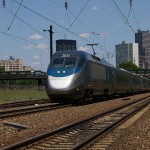Body scanners and other hassles of travel may be a boon for high-speed trains
High-speed trains may become an appealing alternative for American travellers who are irritated and weary over rigorous airport screenings using invasive body scanners and uncomfortable pat-downs not to mention congested traffic conditions in U.S. highways this busy holiday season. While trains have long been a staple of U.S. travel, high-speed trains are now just being slowly considered to transport millions of passengers, with the Obama administration earmarking billions of dollars for high-speed rail projects all over the country in the coming decade.
The U.S. is usually in the forefront of new technology, but not with high-speed trains. Amtrak and other companies have introduced fast trains in recent years but still not fast enough compared to other countries. China for instance, boasts of having the fastest trains on the planet. It is trying to create a 26,000 kilometer railway system with high-speed trains running up to 350 km per hour. In comparison, the fastest Amtrak trains can only go up to 240 km per hour in short stretches. Japan and France had long established their own high-speed rail networks decades ago. The United Kingdom is building a 400 km per hour rail project that would link London and Birmingham.
The Obama administration has acknowledged that the U.S. trails its competitors when it comes to using high-speed trains and allocated over $10 billion to build a true high-speed rail network and other infrastructure projects to meet the future demand of U.S. travel. But the initiative has met some hurdles, primarily because some Republicans who won in the mid-term elections have derailed the projects at the state level.
